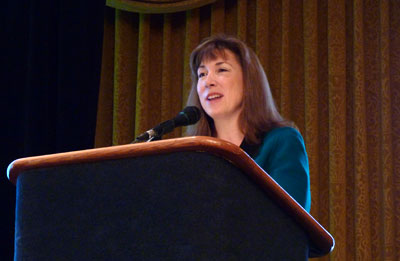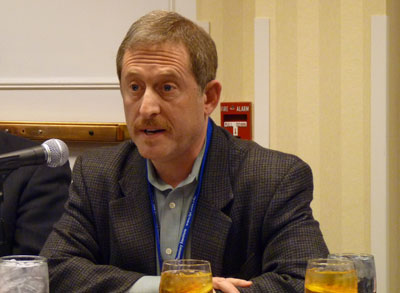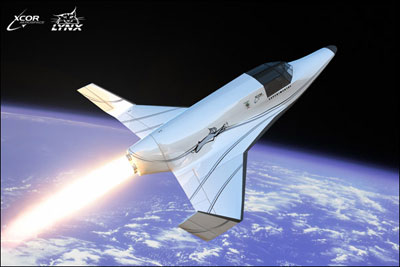Suborbital research gets ready for liftoffby Jeff Foust
|
| “If the price and the flight rate and the g-level and all that stuff about suborbitals that we’re hearing about here work out, suborbital can be very successful,” Weislogel said. “It’s doing a mind change on me.” |
However, the potential of having access to space similar to that provided by some sounding rockets, but for perhaps an order of magnitude lower cost and on a much more frequent basis—and, in many cases, the opportunity for the experiment to be human-tended—has attracted researchers to these vehicles for research that would be difficult or expensive to perform on other vehicles.
For Weislogel, the realization came when he found that many of the experiments he’s performed to study the transport of fluids in microgravity in drop towers and parabolic aircraft could have been done much better on suborbital vehicles. “If the price and the flight rate and the g-level and all that stuff about suborbitals that we’re hearing about here work out, suborbital can be very successful,” he said. “It’s doing a mind change on me.”
In biomedical research, brief flights into space with only several minutes of exposure to microgravity provide some limited opportunities for study. Larry Young of MIT’s Man Vehicle Lab noted that many fields of interest, such as bone and muscle loss and the effects of radiation, aren’t good candidates for suborbital research since they require much longer flight durations. However, suborbital can provide opportunities for research in cardiovascular and neuromuscular topics, such as the retention of particles in the lungs, where only a few minutes of microgravity is needed.
The real benefit of suborbital biomedical research is the potentially large body of test subjects in the form of tourists who will also be flying on these vehicles. This can allow scientists to study the effects of weightlessness over a much larger and more diverse population than is possible today on the ISS or shuttle missions. Anecdotal evidence also suggests that tourists would be willing to participate in passive biomedical monitoring during their flights, and even in some cases more invasive testing.
This, however, has its challenges of its own. “Tourists are probably not going to be the healthiest subjects,” said Marsh Cuttino, an emergency physician. This is an obvious risk, he said, but also provides an opportunity to help doctors and scientists understand what can go wrong.
Using tourists as medical experiments, even just for passive monitoring, raises questions about privacy. There was discussion at the conference about whether such monitoring should be mandatory, which could run afoul of federal regulations that prevent the use of medical data without the consent of the patient. “Every passenger will be an experiment,” said John Charles of NASA’s Johnson Space Center. “The only question is whether we are going to be collecting the data.”
There’s also interest in using commercial suborbital vehicles in astronomy and planetary sciences. While suborbital RLVs don’t fly high enough and long enough for some applications—one speaker noted that daytime observations at ultraviolet wavelengths require flying above an altitude of 120 kilometers, higher than currently planned vehicles are likely to go—there are some studies these vehicles are well-suited for.
| “Every passenger will be an experiment,” said Charles. “The only question is whether we are going to be collecting the data.” |
One example discussed by Stern is the search for “vulcanoids”, asteroids that orbit the Sun closer than Mercury. None have been discovered to date, despite the presence of a stable zone of orbits between the Sun and Mercury, but observing them is difficult since such objects can only be seen for a brief time after sunset or before sunrise. The faintness of these objects coupled with the high sky brightness of twilight has stymied previous efforts to search for them from the ground or even on high-altitude F-18 flights, but Stern believes suborbital flights, going above the atmosphere and thus eliminating the sky brightness problem, would be ideal for searching for them. “This is an example of an experiment which is perfect for next-generation suborbital, where you can put a low-cost experiment, with the astronomer on board, and really go after something neat in the planetary sciences,” he said. “And if you find it, it’s probably front page news.”
Even for those experiments that can’t be done on suborbital RLVs, those vehicles can instead provide an opportunity to test equipment intended for later use on the ISS or other spacecraft. Several speakers in various sessions talked about the potential benefits of suborbital to increase technology readiness levels (TRLs) of equipment, flight-qualifying hardware that may be difficult or impractical to do otherwise. “Suborbital is quality assurance for orbital,” said Michele Brekke of NASA JSC.
 NASA deputy administrator Lori Garver discusses NASA’s funding of the CRuSR suborbital research program at the Next-Generation Suborbital Researchers Conference on February 18. (credit: J. Foust) |
Vehicle developer plans
While scientists discussed ways to make use of suborbital RLVs, companies used the conference to provide updates on the development of their vehicles and the features they offer to researchers. Four companies actively developing suborbital vehicles presented at the conference, including a rare public appearance by Blue Origin, the secretive company funded by Amazon.com founder Jeff Bezos (see “Blue is a little less black”, The Space Review, February 22, 2010).
At perhaps the other extreme in public attention is Virgin Galactic, which just over two months earlier held a gala rollout of its suborbital vehicle, SpaceShipTwo (see “Blown away”, The Space Review, December 14, 2009). Virgin Galactic commercial director Stephen Attenborough said ground tests of SS2 were underway and would likely continue to the end of the quarter. By the end of the quarter SS2 would be ready for its first captive carry flight, where the vehicle is carried aloft by its WhiteKnightTwo carrier aircraft but stays attached throughout the flight. Those captive carry flights, Attenborough continued, would run though the second quarter.
The first SS2 drop test, where the vehicle is released from WhiteKnightTwo and allowed to glide back to earth, is planned for some time in the third quarter of this year. That test, Attenborough admitted, “will be a pretty interesting moment for all of us on the ground, and a pretty interesting moment for the pilot as well.” If all goes well, the first powered test flight would be by the end of the year, with “a lot” of them planned for 2011.
Attenborough, reiterating previous statements by company officials, said that Virgin wasn’t driven to maintain a specific schedule for beginning commercial service, instead focusing on making sure the vehicle was safe. “We can’t cut corners” on the test program, he said. However, in a best-case scenario, Attenborough said he believed SS2 could begin commercial operations as soon as the end of 2011 or early 2012.
While Virgin has shown an interest in supporting research applications of SS2 for over a year (see “Virgin looks beyond space tourism”, The Space Review, February 9, 2009), Attenborough made it clear that for now research was secondary to space tourism, which he described as a market that “will make us a profitable operating company from the very first year of commercial operation.” The research and education market, he said, “could well be a commercially viable business, but I think that there is some work to be done to make sure that it’s structured in the right way.”
“If we’re going to diversify away from space tourism, which I think will make us a lot of money over time,” he concluded, “we need to have a good commercial reason for doing that.”
Other suborbital companies—and even orbital vehicle providers—are also closely examining this market. XCOR Aerospace is developing its Lynx vehicle with an eye towards supporting experimental payloads located either in the interior of the two-seat spaceplane or on various locations on its exterior, including a cargo pod originally designed to host an upper stage for launching nanosats. Flight tests of its Mark 1 Lynx prototype are scheduled to begin in the first half of 2011, with the higher performance Mark 2 to fly 9 to 18 months later. Engines, usually the long pole in the development of any launch vehicle, are not an issue for Lynx, company president Jeff Greason said. “The engines are ahead of the airframe,” he said.
| “If we’re going to diversify away from space tourism, which I think will make us a lot of money over time,” said Attenborough, “we need to have a good commercial reason for doing that.” |
Masten Space Systems is strongly pursuing the research and education market because, unlike some other companies, they have no near-term plans to fly people. In the next few months the company will fly “Xoie v2.0”, an updated version of the vehicle that won Level Two of the Northrop Grumman Lunar Lander Challenge last fall. This vehicle will be equipped with an aeroshell and have the capability to do engine relights, and will be able to fly up to 36 kilometers. XA-0.1G, or “Xogdor”, will be built by October or November, and will pick up where Xoie left off, flying eventually up to 100 kilometers using a new 13,300-newton (3,000-pounds-force) engine under development. “We’re looking at smaller payloads, and we’re also going to be looking at flying them this year,” said company president Dave Masten.
For much larger payloads, an interesting option is under development by NASA’s Kennedy Space Center and United Launch Alliance. The External Payload Carrier, or XPC, looks like a strap-on motor for an Atlas 5, and attaches to the first stage of the rocket as such, but instead would carry payloads of up to a few thousand kilograms on suborbital trajectories to over 200 kilometers. Charles Tetro of KSC said the XPC could be used on NASA missions with excess payload capacities, especially as satellites that were once launched on the Delta 2 are shifted to the higher-performance Atlas 5. “There’s been a shift in philosophy at NASA headquarters,” he said. “They’re starting to recognize that yes, we have excess capability that we’d like to use to get some other research projects into space.”
NASA’s role
NASA’s interest in suborbital goes beyond simply seeking ways to utilize excess capacity on ELVs. Last fall the agency established a new program, called Commercial Reusable Suborbital Research (CRuSR), to help support research programs that could fly on commercial suborbital RLVs. CRuSR is funded at $2.5 million in the current fiscal year, using a combination of funds from the Innovative Partnerships Program (IPP), Science Mission Directorate, and Exploration Systems Mission Directorate (see “Building up a new market for suborbital spaceflight”, The Space Review, December 7, 2009).
NASA, though, plans to up the ante. At the conference NASA deputy administrator Lori Garver announced that the fiscal year 2011 budget proposal includes $15 million for CRuSR as part of IPP. The five-year budget plan would continue to fund CRuSR at the same level, for a total of $75 million over five years.
Garver said by supporting suborbital research, it helps support the development of an overall industry that could provide the agency and the nation with much greater benefits in the future. “We believe in the suborbital market and the possibilities for the government to stimulate the development of the new orbital capabilities that will evolve from suborbital,” she said. “Suborbital puts us on a sustainable, step-by-step path to build an industry that evolves to low cost access to orbit.”
“NASA’s interest in this is not just to help this industry get started, but to help do research, to do cutting-edge world-class research,” said Pete Worden, director of NASA’s Ames Research Center, where the CRuSR office is based. Added Mike Skidmore, who runs the CRuSR office at Ames, “this is an opportunity that we can’t pass up.”
The details of how CRuSR will support this research are still being worked out, but one thing it will not include, at least in the near term, is funding researchers to fly on those vehicles. NASA went to far as to distribute a statement to media attending the conference to clarify this point. “The CRuSR Program plans to purchase flight services for untended payloads supporting science, technology, and education,” it stated. “NASA will not be paying for humans to fly on the commercial vehicles until NASA determines the vehicles meet NASA standards for human safety.” (emphasis in original)
| “Suborbital puts us on a sustainable, step-by-step path to build an industry that evolves to low cost access to orbit,” said Garver. |
However, that doesn’t stop other organizations from spending money to fly researchers. At the conference, Southwest Research Institute (SwRI), where Stern currently works as associate vice president of its space science and engineering division, announced that it was setting aside about $1 million for flying experiments and researchers on commercial suborbital vehicles. “We’re so excited that we’re not even waiting on the government,” Stern said at a press conference during the meeting.
NASA’s embrace of commercial suborbital also has the support of a newly-released study by the Space Studies Board of the National Research Council. The report, which broadly examined NASA’s suborbital research programs, saw potential benefits of using commercial suborbital RLVs for research by NASA as well as other federal agencies. “Commercial suborbital vehicles, once successfully developed and proven, have the potential to provide increased, low cost opportunities for research, technology development and educational experiences, complementing NASA’s existing suborbital capabilities,” the report stated, adding that such vehicles “should seriously be considered” by a committee performing a decadal survey for biological and physical sciences in space.
 Alan Stern discusses how his organization, SwRI, plans to invest $1 million into flying payloads and researchers on commercial suborbital vehicles. (credit: J. Foust) |
Issues and concerns
While scientists and researchers at the conference appeared to embrace the potential of commercial suborbital vehicles to perform science, and NASA appears willing to support such research, there are still issues, primarily at the implementation level, to overcome before suborbital vehicles starting flying experiments and perhaps experimenters.
One topic for debate is what standards, if any, are needed for integrating payloads onto vehicles. Some have advocated for using an existing, well-understood format, middeck lockers. “The ISS middeck locker is the chariot wheels of the 21st century,” said Chuck Lauer of Rocketplane Global. “I think 19-inch boxes will be the de facto standards for a long time.” Others, though, argued for more flexible, simpler formats that could handle much smaller experiments.
Another concern is whether experiments and tourists mix. For some biomedical applications, tourists may be the experiment, as researchers measure their adaptation to weightlessness and back. However, for microgravity science and astronomy applications, tourists could be a nuisance: bouncing around the cabin, they could run into researchers and their experiments, or reduce the overall microgravity environment on the vehicle; tourists would also prefer to look down on the Earth while astronomers want to look up into space. “I think it’s problematic” to combine science and tourism, said Luke Sollitt, an astronomer at The Citadel.
These issues suggest the need for third-party “payload integrators”: organizations that would with researchers and vehicle operators to arrange flights for experiments, handling the technical details of integrating the experiments on the vehicles and ensuring that the experiments on each flight are complimentary. This might lead to “science charter” suborbital flights, where a vehicle is reserved exclusively for scientific applications.
| The conference “was really about getting over the giggle factor that researchers would fly in space,” said Stern. “This is really a meeting about education.” |
The fact that the debate has focused more on implementation and operational issues suggests that, at least for the scientists and vehicle developers attending the conference, there is a strong belief that commercial suborbital RLVs can serve the research and education market. While such vehicles can’t meet the needs of every researcher, there is enough interest in such vehicles, particularly at the price points and flight rates promised by vehicle developers, to stimulate strong interest and perhaps even new uses of space for research.
“That gets you into the realm of what I call ‘what if’ science,” said Michael Mealling of Masten Space Systems. “Once we get down to the ‘impulse aisle at the grocery store’ kind of flights, that really changes how you do science and whether or not you can do speculation… That’s really going to be one of the fundamental changes that happens here.”
Last month’s conference “was really about getting over the giggle factor that researchers would fly in space,” said Stern at a press conference during the meeting. “This is really a meeting about education. We’re educating you all that there are scientists who are interested. We’re educating the providers that the scientific community is a real market for them, with real and different needs from tourists. We’re also educating the various facets of the research and education community that this is a very real enterprise and that it does offer opportunity.”
That desire to educate means that the conference, originally intended to be a one-time event, will be the first in an annual series of meetings. The second such conference is planned for next February at the University of Central Florida in Orlando, with a third planned for 2012 at NASA Ames. Based on last month’s event, though, it’s doubtful that the organizers of those future conferences will have to worry about filling a meeting room.
